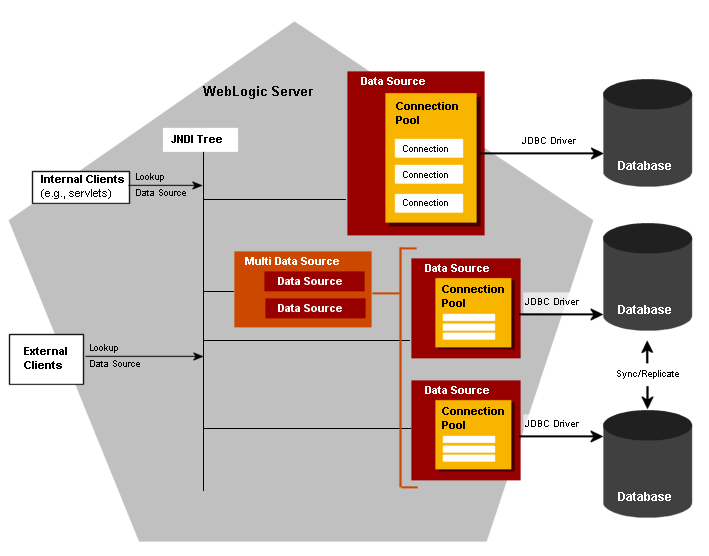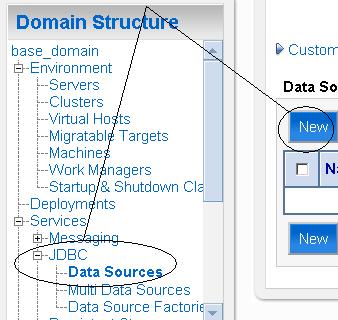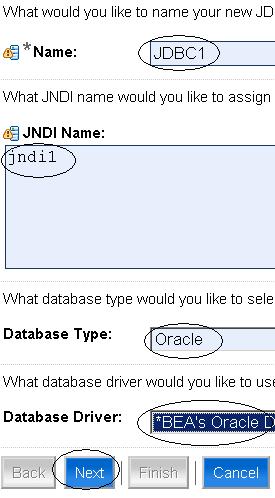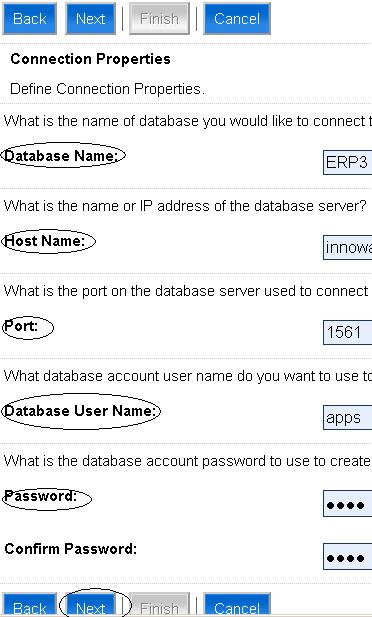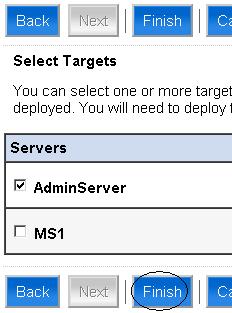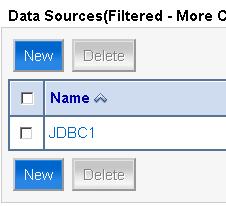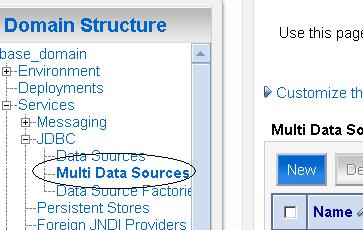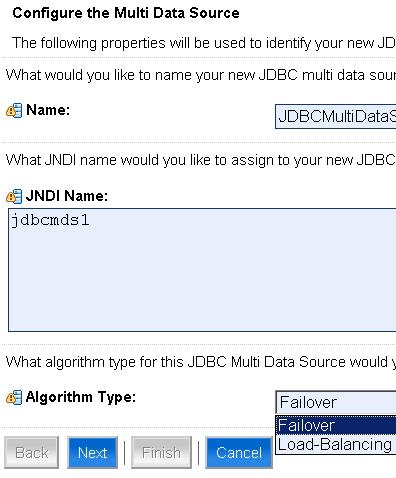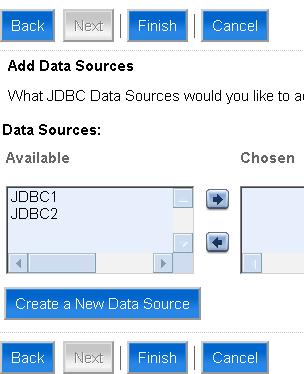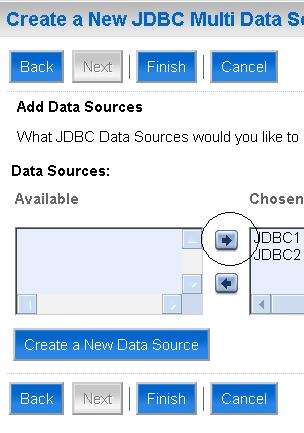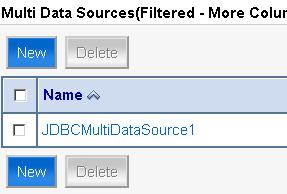Leave a Comment:
30 comments
Thank you for this good summary.
I believe there is one critical limitation you did not mention. While you can deploy an application with an ID using the deployer role, surprisingly it requires an admin role to create the associated JDBC conenction pools (and Datasources). Have you found a way around it?
Hi Atul,
A nice intro on data source configuration. thank you, by the way we are facing one problem from OC4J time, i.e. changing password of data source user mandates server restart, is it possible to get ride of this.
I tried Datasource -> Control
Shutdown/ Start but still no hope.
Thanks
Arunachalam.C
Lead Consultant BPEL
Emaar Business Park, Building 3, Level 4
IT Department,
PO Box 9440,
Dubai, United Arab Emirates
Direct tel: + 971 4 3673878
Mobile: + 971 507882908
Hi Atul,
This is good doc. Thanks for taking efforts to put this together.
I have a question:
I am trying to to connect from OmniPortlet to SQL Server database. I think, I have to register the database driver in provider.xml .
But when I search for this file, I see many provider.xml files in middleware home. The doc says modify the file from “OmniPortlet_WAR_DIRECTORY/WEB-INF/providers/omniPortlet” directory. Do you know exactly which provider.xml to modify. I am looking for exact file location on windows server.
Thanks for your time.
Hi Atul,
I installed Weblogic, but i don’t see Teradata in the drop down list of databases. Is there any workaround to connect teradata database.
Thanks
Aj
@ Aj,
You would need teradat related jar files in classpath. Check steps here
http://www.teradata.com/DownloadCenter/Topic9448-98-1.aspx#beawl10.3
ReplyHi Atul,
My final goal of connecting teradata from weblogic was to install OBIEE11g. What are the next steps to follow for successfull installation of 11g. When i run the RCU utility i have only three options for databases(Oracle/Sql Server/DB2). Is there any work around to get Teradata as the drop down option in RCU utility tool.
Reply@ Ajit,
I don’t think Teradata is certified with RCU check this page for RCU certification http://www.oracle.com/technetwork/middleware/ias/downloads/fusion-requirements-100147.html#CHDJGECA
Contact Oracle Support if you need Tearadata as repository
ReplyAtul,
Thanks for your response. I know that RCU doesn’t support Teradata. I thought there might be some workaround to connect to Teradata.
May be i need to wait for next release when Oracle will be gracious enough to support all databases rather just 3.
Once again thanks for yours response.
Ajit
Reply[…] Create JDBC in domain with JNDI as jndi/FICMASTER (For steps on how to create/configure JDBC in WebLogic click here […]
ReplyHi Atul,
i wanna ask you something bout the connection of weblogic server.
sometimes my apps get error http 500 or connection already closed. so users must refresh or logout n login again.
i think maybe it’s because the connection pool in oracle database or in oracle weblogic server that may this happen.
need advice Atul,
i’m really appreciate for your help
Rgrds
LILIEK
Reply@ liliek,
For 500 error , you need to check application logs to find why users get this error (It is difficult to tell reason without looking at logs)
Hi atul, talking about datasource?
why you need to assign both
admin server and managed server with a datasource?
based on my knowledge, i usually assign just one managed server for one datasource.
may i know why you do that? ( assign one datasource to admin server and managed server )
what will happen if i not put admin server into datasource?
Replyhi atul
i think because the admin server not receive request from user , managed server does. so that why i’m curious to assign admin server into datasource.
Reply@ liliek,
JDBC needs to target to servers that have any application which needs database connection.
If you have any application like apps1 deployed on AdminServer and apps1 need database connection, you then need to target JDBC to AdminServer. If there is no application deployed on AdminServer (that requires database connection) then you don’t need to target JDBC to AdminServer.
Traget of JDBC to AdminServer in above post is just as an example and is not mandatory.
ReplyHi Atul,
From where we can get/find the JNDI name to configure at the data source.
Replyfollowing is my error:
Message icon – Error Connection test failed.
Message icon – Error IO Error: The Network Adapter could not establish the connectionoracle.jdbc.driver.T4CConnection.logon(T4CConnection.java:743)oracle.jdbc.driver.PhysicalConnection.connect(PhysicalConnection.java:666)oracle.jdbc.driver.T4CDriverExtension.getConnection(T4CDriverExtension.java:32)oracle.jdbc.driver.OracleDriver.connect(OracleDriver.java:566)weblogic.jdbc.common.internal.DataSourceUtil.testConnection0(DataSourceUtil.java:340)weblogic.jdbc.common.internal.DataSourceUtil.access$000(DataSourceUtil.java:22)weblogic.jdbc.common.internal.DataSourceUtil$1.run(DataSourceUtil.java:254)java.security.AccessController.doPrivileged(Native Method)weblogic.jdbc.common.internal.DataSourceUtil.testConnection(DataSourceUtil.java:251)com.bea.console.utils.jdbc.JDBCUtils.testConnection(JDBCUtils.java:751)com.bea.console.actions.jdbc.datasources.createjdbcdatasource.CreateJDBCDataSource.testConnectionConfiguration(CreateJDBCDataSource.java:479)sun.reflect.NativeMethodAccessorImpl.invoke0(Native Method)sun.reflect.NativeMethodAccessorImpl.invoke(NativeMethodAccessorImpl.java:57)sun.reflect.DelegatingMethodAccessorImpl.invoke(DelegatingMethodAccessorImpl.java:43)java.lang.reflect.Method.invoke(Method.java:606)org.apache.beehive.netui.pageflow.FlowController.invokeActionMethod(FlowController.java:870)org.apache.beehive.netui.pageflow.FlowController.getActionMethodForward(FlowController.java:809)org.apache.beehive.netui.pageflow.FlowController.internalExecute(FlowController.java:478)org.apache.beehive.netui.pageflow.PageFlowController.internalExecute(PageFlowController.java:306)org.apache.beehive.netui.pageflow.FlowController.execute(FlowController.java:336)…
@Kalyan,
Multi Datasource is used when you have Oracle RAC Databases, they provide high availability to database connection .
On the database side you have two database instances (both pointing to same database) , on weblogic side each datasource points to rac instance so if a instance goes down other datasource pointing to second DB instance can take care of it .
Atul
ReplyHello sir,
I have created 3 managed server instances in WLS 11g.In those 2 server instances having Different .war (application ) files But Assgined to same DataSource ,
serevr1 – Datasource(A)
server2 – Datasource(A)
can we give this to Practical scenario??>
is this Valid ?? please tell me ..Reply me to
‘nlkalyan.434@gmail.com”
Thanks for the Dsta Source creation info.
How to find out the Multi Datasource creation date .Could any one help me on this..
Reply@pranay, Not sure if you can find out creation date (just check file creation date for Data source config file at $DOMAIN_HOME/config/jdbc/
ReplyI think it is important that the information they need is in the tnsnames.org file, since each network alias may have a SID or Service_Name. As, I eventually found out. Based on the SID or Service_Name will determine what Database Driver you will need to use.
If the Database Driver has a ‘word of Service’ you should use the ‘Oracle’s Driver(Thin XA) for Service connection;Versions:9.01 and later.” For Database Driver with the ‘word Instance connections’ use ‘Oracle’s Driver(Thin XA) for Instance connection;Versions:9.01 and later.”
Hello Atul,
I have an EBS R12.2 environment where the DB listener is SSL enabled. I also have a 11g SOA installation (11.1.0.7 SOA, with 10.3.6 weblogic). I am trying to configure a datasource to connect to the EBS database using the SSL listener. The EBS database is a 4 node RAC instance with SCAN listener. The JDBC thin client URL is set to use the scan listener that is ssl enabled. I am getting the below error.
<Failed to initialize the application 'XXSOAEBSDataSource_DS' due to error weblogic.application.ModuleException: .
weblogic.application.ModuleException:
at weblogic.jdbc.module.JDBCModule.prepare(JDBCModule.java:327)
at weblogic.application.internal.flow.ModuleListenerInvoker.prepare(ModuleListenerInvoker.java:199)
at weblogic.application.internal.flow.DeploymentCallbackFlow$1.next(DeploymentCallbackFlow.java:518)
at weblogic.application.utils.StateMachineDriver.nextState(StateMachineDriver.java:52)
at weblogic.application.internal.flow.DeploymentCallbackFlow.prepare(DeploymentCallbackFlow.java:159)
Truncated. see log file for complete stacktrace
Caused By: weblogic.common.ResourceException: weblogic.common.ResourceException: Could not create pool connection. The DBMS driver exception was: IO Error: Connection reset
at weblogic.jdbc.common.internal.ConnectionEnvFactory.createResource(ConnectionEnvFactory.java:285)
at weblogic.common.resourcepool.ResourcePoolImpl.makeResources(ResourcePoolImpl.java:1322)
at weblogic.common.resourcepool.ResourcePoolImpl.makeResources(ResourcePoolImpl.java:1239)
at weblogic.common.resourcepool.ResourcePoolImpl.start(ResourcePoolImpl.java:250)
at weblogic.jdbc.common.internal.ConnectionPool.doStart(ConnectionPool.java:1330)
Truncated. see log file for complete stacktrace
Have tried to debug so far without much luck. Wanted to know if there is something obvious that I may be missing. Please advice.
Thanks,
Dhilip Ranganathan.
@Dhilip, I am assuming this SOA is installed on separate machine from where connection is coming . If this is the case then entry of SOA host should also be in FND_NODES and from sqlnet.ora connection should be allowed . Let me see if we have this topic covered in our Oracle Apps DBA Training at http://k21academy.com/oracle-apps-dba/Oracle Apps DBA Training
ReplyExactly what I’ve been looking for! Thanks for sharing such guide and summary!
ReplyI wanted to configure/create RCU with SSL DB port. as it says invalid port. Is this something known or needs some different steps for installing RCU
Reply
